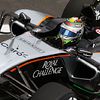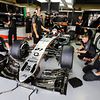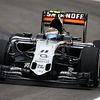Sahara Force India VJM08 Mercedes

Active: 19-02-2015 - 21-06-2015
Team: Force India F1
Team: Andrew Green (TD), Andy Stevenson (SD), Bob Halliwell (Production Director), Simon Philips (Aerodynamics Director), Akio Haga (CD), Ian Hall (CD), Tom McCullough (CE), Mark Gray (TM), Vijay Mallya (TP), Robert Fernley (DTP), Otmar Szafnauger (COO)
Drivers: Sergio Perez (11), Nico Hulkenberg (27), Pascal Wehrlein (34, Test)
Sahara Force India made a late start to 2015 with their VJM08, skipping the first pre-season test at Jerez before opting to use their previous VJM07 at the first Barcelona test. The team officially unveiled their new car at an event in the Museo Soumaya in Mexico City on 21 January 2015, even though that turned out to be a 2014 chassis with an even older rear wing and an adapted nose cone.
The car eventually debuted on 19 February, even though its first stint turned out to be extremely short, with a rim problem causing a flat left rear tyre and subsequently created some car damage. Things improved from there on, and Force India went on to score a double points finish in the first race at Melbourne.
Rumours of the team having financial difficulty were pinpointed as the reason for the car's delay, but the team itself insisted it was due to their operational overhead of switching to the TMG windtunnel at Cologne.
"Working solely in the TMG wind tunnel will help our development significantly," said Technical Director Andrew Green, "having the ability to run 60% models will represent a significant step forward in fidelity of the data we receive and will in turn improve our correlation between the wind tunnel results and the on-track car data. The model itself has a significant increase in aerodynamic loading and it has been a challenge designing and building a new model in a very short time frame.
"The tunnel, however, is not the only course we are taking to improve our performance," he continues. "We are also looking to step up our simulator programme in order to deliver a 'state of the art' tool that will help us develop more in the virtual world and allow us to explore new directions and developments. The combination of the new wind tunnel and simulator will also be aided by the ramping up of our CFD capabilities; we are now operating with 30 teraflops of computing power - a massive change compared to the 0.3 teraflops we had five years ago. We expect the fruits of this investment to start feeding into the development of the car throughout the 2015 season and beyond."
Indeed, the team introduced their first car updates coming from the Cologne windtunnel at the Spanish Grand Prix in May, but its major step forward was only made by the introduction of the VJM08B at the Great Britain Grand Prix, the 9th event of the championship.
Technically, the car itself featured mostly modifications to adapt to the changed regulations. Some were undoubtedly complex, with for instance the introduction of hydro-mechanical suspension at the rear, replacing the previously used torsion springs. This was made possible thanks to creating a new technical partnership with Koni and was aimed at widening car set-up options. Force India also worked closely with Motegi on new wheel rims. The increased minimum weight meanwhile made things a bit easier for the team, as Green said it enabled them to be a little less aggressive in some areas, while making it possible to comfortably by within the weight distribution limits that the regulations stipulate.
On the aerodynamic front, the car is clearly very different at the front compared to its predecessor, as the team's previous extreme finger nose concept was ruled out, dropped a considerable amount of downforce. The team still managed to claw all of that lost downforce back, partly thanks to more tightly sculpted sidepods and new cooling intakes.

Specifications
Chassis: Carbon-fibre monocoque
Front suspension: Aluminium alloy uprights with carbon fibre wishbones, inboard torsion springs, dampers and anti-roll bar assembly, actuated by push-rods
Rear suspension: Aluminium alloy uprights with carbon fibre wishbones, inboard hydro-mechanical springs, dampers and anti-roll bar assembly, actuated by pull-rods
Dampers: Koni
Brakes: AP Racing callipers with Carbon Industries carbon fibre pads and discs
Transmission: Mercedes AMG F1 8-speed quick-shift sequential carbon-cased gearbox, hydraulically activated. Longitudinally mounted
Clutch: Carbon fibre plates
Electronics: FIA standard ECU and FIA homologated electronic and electrical system (as provided by MES)
Steering wheel: Sahara Force India F1
Tyres: Pirelli
Wheels: Motegi Racing, forged magnesium alloy
Dimensions
Height: 950 mm (minus T camera)
Track width: 1,460 mm (front); 1,416 mm (rear)
Weight: 702kg (FIA mininum; incl. driver and lubricants, tank empty)
Powertrain
Designation: Mercedes-Benz PU106B Hybrid
Type: Turbocharged, 90° 1.6l V6, assisted with kinetic and heat ERS
No of valves: 24 (4 per cylinder)
Fuel injection: High-pressure direct injection (max 500 bar, one injector/cylinder)
Pressure charging: Single-stage compressor and exhaust turbine on a common shaft
Bore: 80mm
Stroke: 53mm
Crank height: 90mm (minimum allowed)
Energy recovery system: Integrated Hybrid energy recovery via electrical Motor Generator Units
Energy Store: Lithium-Ion battery solution, between 20 and 25 kg
Fuel: PETRONAS Primax
Lubricants: PETRONAS Syntium
Gearbox & hydraulic oil: PETRONAS Tutela




